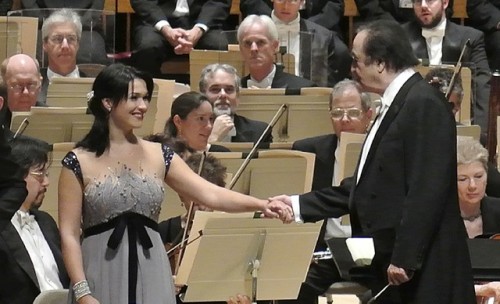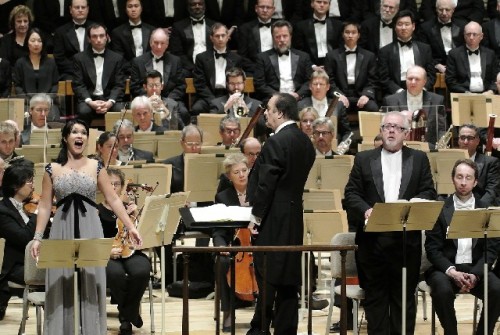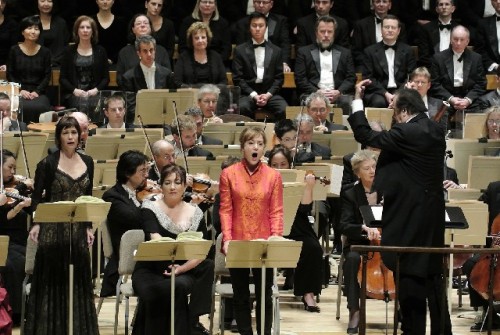Charles Dutoit Conducts the Boston Symphony Orchestra
Stravinsky's Le Rossignol and L’Enfant et les sortileges of Ravel
By: David Bonetti - Oct 29, 2012
“Le Rossignol” (The Nightingale) by Igor Stravinsky|
Libretto by Stepan Mitusov after a tale by Hans Christian Andersen
“L’Enfant et les sortileges” (The Child and the Magic Spells) by Maurice Ravel
Libretto by Colette
Conducted by Charles Dutoit
Boston Symphony Orchestra
Symphony Hall
Oct. 25, 26, 27
Cast: Olga Peretyatko, soprano (the nightingale in Stravinsky); Julie Boulianne, mezzo-soprano (the child in Ravel). Sandrine Piau, soprano; Diana Axentii and Yvonne Nael, mezzo-sopranos; Edgaras Montvidas and Jean-Paul Fouchecourt, tenors; David Wilson-Johnson, David Kravitz and Kelly Markgraf, baritones; Mattew Rose, bass, all singing multiple roles in both operas.
Tanglewood Festival Chorus conducted by John Oliver
The Boston Symphony Orchestra, one of the greatest bands still standing - Mick and Keith’s outfit notwithstanding - has been rudderless for years now. Music director Seiji Ozawa’s last years were marked by drift, but at least he functioned fully as a music director. The short unfortunate regime of James Levine started out from all reports with energy and vision. But Levine’s inner megalomaniac refused to face the reality of his medical condition, not caring how many great music institutions he brought down with him. And he never did the things a music director should do like audition new members or take part in the larger music community.
The orchestra remains sharp even as it runs on inertia. But the management has been clueless when it comes to programming. Whoever thinks that Izthak Perlman playing and conducting Beethoven or Yo-Yo Ma playing the Dvorak cello concerto for the thousandth time is enticing fare in the early 21ist century is clearly out of touch.
Charles Dutoit to the rescue. The veteran Swiss conductor, long associated with the Montreal Symphony Orchestra, where he was artistic director from 1977 to 2002, put together this past weekend a program of two rarely performed early 20th century operas with which he has been closely associated and which it would seem that the BSO was created to play. Amazingly, it had never played one of them, and Dutoit said in an online interview on the BSO’s website that to his knowledge the two had never been programmed together anywhere.
The two works, Igor Stravinsky’s World War I-era “lyric tale” “Le Rossignol” (The Nightingale) and Maurice Ravel’s “lyric fantasy” from a decade later, “L’Enfant et les sortilege” (The Child and the Magic Spells) are by composers that had a regular home at the BSO under legendary conductor and music director Serge Koussevitsky. Indeed, Stravinsky dedicated his great “Symphony of Psalms” “to the glory of God and the Boston Symphony Orchestra.” All the more of a mystery that his 1914 “Le Rossignol” had to wait nearly 100 years to get a hearing here.
Again, Dutoit has an explanation: Both works are only 45 minutes long and require a large orchestra, chorus and cast of vocal soloists – there are nine in each work - some of whom get only a few lines to sing. His remedy was to combine them and use singers in both works where possible, necessitating only 11 singers for the evening.
Both works are oddities within the composers’ oeuvre, but that makes them even more of a delight to encounter. And both works are based on works by significant literary figures. “Le Rossignol” is based on a tale by Hans Christian Andersen, who wrote childrens’ stories that appeal equally to adults. The risque novelist Colette asked Ravel to set her original libretto. If you want to look for literary qualities in both, you can.
The young Stravinsky took four years off between writing the “Le Rossignol”’s first and final two acts, four years during which he composed his three great ballets, “Petruska,” “The Firebird,” and “The Rite of Spring.” When he resumed working on “Le Rossignol” he was not the same composer. The work, which Dutoit says is not an opera, was first produced by Serge Diaghilev’s Ballets Russes at the Opera House in Paris.
The first act is suffused with the perfume of symbolism, Debussy the heavy influence, the orchestra shimmering with color. The opening chords, a set of lazy, languorous phrases in the strings, punctuated by bird sounds in the winds, immediately pulls you into a dream state, not unlike the opening passages of Debussy’s “Pelleas et Melisande.”
The story is one you could imagine Debussy or a disciple like Paul Dukas addressing on their own. A fisherman waits at dawn for the ravishing song of a nightingale, the sensuous overture suggesting the overlapping wavelets of the lake where he is fishing. Emissaries of the Chinese Emperor come to investigate and bring the miraculous bird back to the court. The Emperor is charmed, but the bird prefers its freedom and flies away. Japanese envoys substitute a mechanical bird, which suffices until the Emperor takes ill. The real nightingale comes back, enchants Death, and the Emperor revives. Offered a reward, she sings, “The tears that fill your eyes are my reward, Emperor.”
Stravinsky indulges in Orientalism, and uses what Europeans heard as Chinese chords in all three acts. (Orientalism was hugely popular in European art of the late 19th and early 20th centuries, the age of colonialism. Mahler in the “Song of the Earth” and Puccini in “Turandot” are just two who toyed with Chinese tonalities in China-based tales. Other works evoked Egypt, Japan, India and Java as well.)
But even though the Oriental tone continues in the final two acts, the perfume is not quite so thick. Emboldened by “The Rite of Spring,” Stravinsky brings a more propulsive rhythmic thrust to the final two acts, giving them a greater sense of urgency. He also accentuates the orchestral color. Always a master of color – strings never dominate in Stravinsky as they do in the Germanic tradition – he uses the woodwinds, horns and percussive instruments (glockenspiel, three kinds of cymbals, tambourine, side and bass drum, triangle and tam-tam) with even greater freedom. In the work, Stravinsky created a rich tapestry of orchestral sound that supports the vocal tapestry interwoven with it. This is a work one could hear again and again. One hopes that the BSO programs it again soon.
The cast was just about perfect. As the Fisherman, the everyman whose short song opens the opera and concludes each of the three acts, heard four times in all, Lithuanian tenor Edgaras Montvidas had a steady, well-modulated voice that captured the wisfulness of the work.
The work belonged to Olga Peretyatko, who sang the role of the Nightingale. A Russian trained in St. Petersburg, she has sung early opera, bel canto and the Russian repertoire in major houses all over the world. In the last few years she has made the Nightingale a specialty. Peretyatko possesses one of those perfect soprano voices, clear as glass, able to hit high notes without apparent effort. She is as sensitive to the text as she is to the notes, and the fact that Russian is her native language made a difference here. Her arias are preceded and accompanied by passages of flute, which so naturally suggests the song of a bird. In this work if no other, Stravinsky shows a natural affinity for birdsong that his later contemporary Olivier Messaien made central to his visionary music.
The remaining singers were all well-cast, with a special shout-out to David Wilson-Johnson, who sang the Emperor with an exquisite sense of Oriental petulance.
Dutoit conducted with deep understanding of the text. He kept the rhythms moving, but he also drew out the tiny motifs in the woodwinds and horns that gave the tonal tapestry such richness.
Ravel’s “L’Enfant et les Sortilege,” which was first produced in 1925 at the Monte Carlo Opera, is not such a rarity, although it is by no means part of the central repertory. The BSO has performed it three times before, all under the baton of Ozawa.
A fairy tale colonizing Maurice Sendak territory a half century before the American illustrator hit on the idea, it tells the story of a bad boy who throws a hissy fit when he doesn’t want to do his homework, tearing up his exercise books, breaking his tea cup, stabbing his caged squirrel, pulling the cat’s tail, tearing the wallpaper, etc. until the objects he has been abusing come to life and retaliate. The action moves to the garden, where the tree he has cut with his knife, the frogs he has tortured and the dragonfly whose mate is pinned to the wall of his room join in punishing the miscreant. The opera is devoted to the delight of watching – in this case, a concert version, alas, just hearing – the wronged objects express their hurt. It all ends when in the chaos that ensues, the boy binds up a squirrel’s wounds, and his former antagonists agree that he is not such a mechant garcon after all. A typically French ending to a totally inconsequential and totally charming work.
Ravel was an equal to Stravinsky in his love of orchestral color, and his orchestra is even more filled with strange and exotic instruments. Among percussion instruments, in addition to the “standard” timpani, kettledrum, triangle, tambourine, side and bass drums, cymbals and tam-tam, Ravel calls for whip, rattle, rasp, cheese-grater, wind-machine and xylophone. The opera opens with a strange-sounding keyboard instrument – the piano lutheal, which no longer exists, so a prepared piano was used instead - that produces a sound unique to this particular work.
He was not the type of composer who turned out 46 symphonies and 126 string quartets. Like Debussy and Stravinsky and many of the composers who followed them, he approached each new work on its own terms. He wrote a great string quartet, but like Debussy, he wrote only one. Stravinsky wrote several operas, none of which followed the normal rules of the game, but Ravel wrote only one other than “L’Enfant …”
In addition to experimenting with musical forms, he also experimented with musical styles and traditions. Like many of his contemporaries, he looked back to the baroque and rococo ages. When the shepherd (mezzo-soprano Diana Axentii) and shepherdess (Sandrine Piau) break out of the wallpaper the bad boy has torn, they sing to a little 18th century country-dance tune. Ravel also looked to ragtime, jazz and other African-American musical genres. There are appropriatons of Kurt Weill, himself appropriating American jazz. And at times in the chaos of the war of the inanimate objects, he has his orchestra make sound effects of the sort that Spike Jones would only a decade or so later in an entirely different context.
As in “Le Rossignol,” the orchestra is rich in its subtleties, which Maestro Dutoit brought out without underlining them.
The Child, Canadian mezzo-soprano Julie Boulianne captured the essential innocence of the bad boy with understated wit. The rest of the large cast had a lot of very specific things to do. Wilson-Johnson, who sang such an imperial Chinese Emperor in “Le Rossignol,” intoned “ding-dong, ding-dong” as the broken clock and hilariously got into character as the spitting black cat. Soprano Sandrine Piau, a star in the early music world, beautifully sang the role of the wounded Princess whose page the bad boy tore out of a story book. And tenor Jean-Paul Fouchecourt, another early music star, equaled Wilson-Johnson for evocative sound-making: As the arithmetic book, he spouted out incorrect mathematical additions with the madness of the mad hatter – indeed, the opera is reminiscent of the tea party in “Alice in Wonderland ” - and as the frog he stuttered hilariously like a frog croaking in its swamp. (By the way, casting Fouchecourt as the frog might be considered something of an inside joke: he made his biggest splash, as it were, playing the frog bride in Mark Morris’s version of Rameau’s 17th century opera “Platee.” At least we can say with certitude that Fouchecourt has cornered the market on operatic frogs.)
The BSO has been flirting with offering Dutoit a greater role in the orchestra – at least that’s what the runors say. If his double-header of one-act operas is any indication of the imagination he could bring to programming, I say “sign him up now.”
APOLOGIA: In my recent review of the BSO’s “Porgy and Bess” I contrasted the miked version Diane Paulus produced for the American Repertory Theater at Harvard unfavorably with the BSO’s unmiked version. Alas, my ears deceived me: the singers were, in fact, miked at Symphony Hall, which Boston Globe critic Jeremy Eichler found unnecessary and offensive. I have to admit that I was so pleased by the full, rich and unmiked sound the orchestra made that I lazily assumed that the singers were singing without electronic aid as well.
But something in Eichler’s review gave me pause. He said that because of the miking, the singers threatened to overpower the orchestra. My experience was exactly the reverse. My initial joy at hearing the full power of the BSO soured as I realized that the large orchestra and the enormous chorus violated the nature of what Gershwin called a “folk opera” AND THREATENED TO OVERPOWER THE SINGERS! I had good critic’s seats in the orchestra; I assume Eichler had even better ones. How could he hear the miked singers overpowering the orchestra while I heard the orchestra overpowering the singers? One of those mysteries of individual acoustic experience I guess. In any case, if the singers were miked, I apologize for not recognizing the fact and misreporting it in Berkshire Fine Arts.




